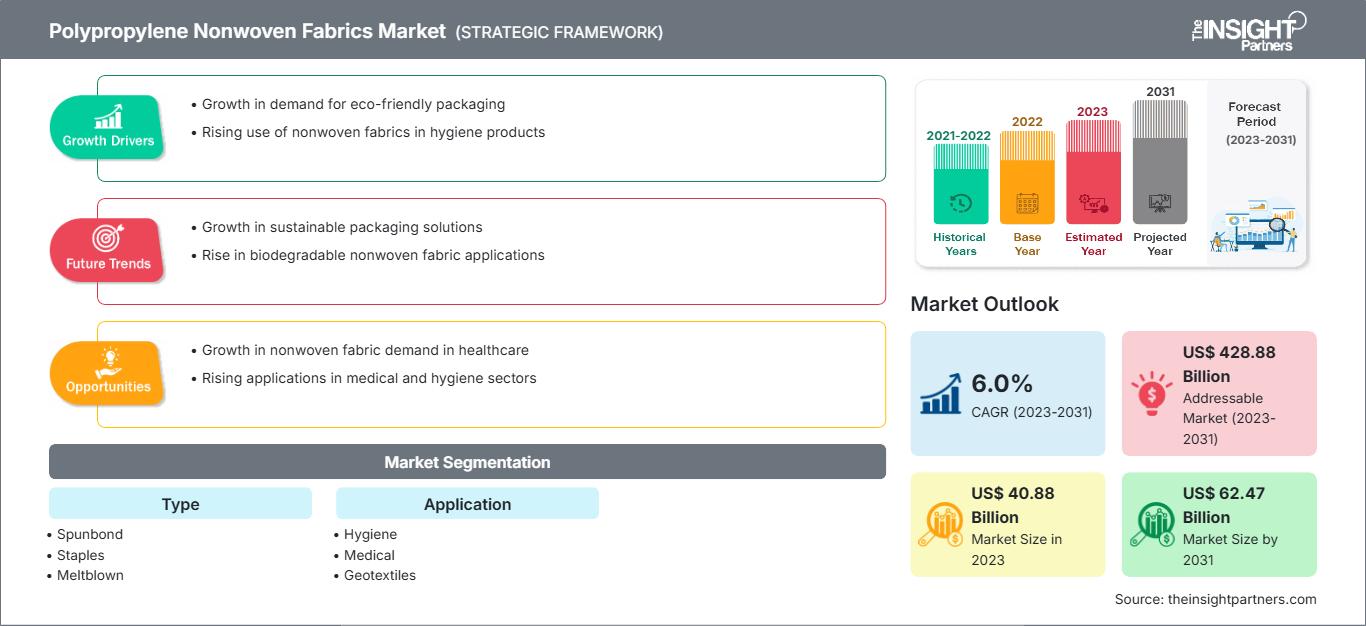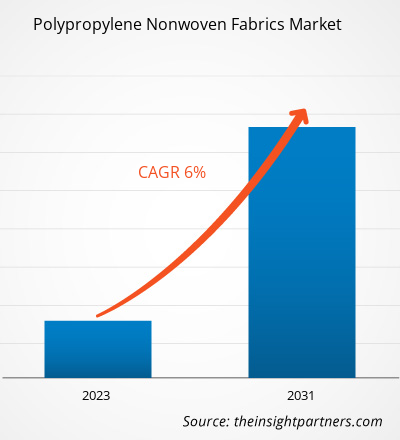Se prevé que el mercado de telas no tejidas de polipropileno alcance los 62.470 millones de dólares estadounidenses en 2031, frente a los 40.880 millones de dólares estadounidenses en 2023. Se espera que el mercado registre una tasa de crecimiento anual compuesta (TCAC) del 6,0 % entre 2023 y 2031. La creciente demanda de sectores de aplicación como la agricultura y la construcción probablemente seguirá siendo una tendencia clave en el mercado de telas no tejidas de polipropileno .
Análisis del mercado de telas no tejidas de polipropileno
La creciente demanda en el sector geotextil ha impulsado significativamente el crecimiento del mercado de telas no tejidas de polipropileno . Los geotextiles son cruciales en proyectos de ingeniería civil y construcción, ya que cumplen funciones como el control de la erosión, la estabilización del suelo y el drenaje. Las propiedades esenciales de estas telas, como su resistencia, permeabilidad y resistencia a factores ambientales, las convierten en un material preferido para aplicaciones geotextiles . Con el creciente número de proyectos de desarrollo de infraestructura, existe una necesidad cada vez mayor de materiales confiables y duraderos para mejorar la longevidad y la estabilidad de las estructuras. Las telas no tejidas de polipropileno también proporcionan una separación eficiente de las capas del suelo, ofrecen refuerzo en áreas con terreno inestable y previenen la erosión. Estas telas son ligeras, lo que facilita su instalación y manipulación en aplicaciones geotextiles , reduciendo así los costos de mano de obra y transporte. Además, presentan una excelente resistencia a la degradación química y biológica, lo que garantiza un rendimiento duradero en diferentes condiciones ambientales.
Panorama del mercado de telas no tejidas de polipropileno
Los tejidos no tejidos de polipropileno ofrecen una alta resistencia a líquidos y contaminantes, lo que los hace ideales para aplicaciones en textiles médicos y productos de higiene. Estos tejidos también se utilizan ampliamente en la fabricación de batas quirúrgicas, mascarillas y paños quirúrgicos en el sector médico. La resistencia del polipropileno garantiza la durabilidad de los tejidos no tejidos , brindando protección tanto a los profesionales sanitarios como a los pacientes durante su uso. Además, la transpirabilidad de los tejidos no tejidos de polipropileno es fundamental para garantizar la comodidad, ya que permite el paso de la humedad del aire al tiempo que mantiene una barrera protectora contra los microorganismos. Las características únicas del tejido no tejido de polipropileno benefician a diversos productos de higiene, como pañales y compresas higiénicas. Su suavidad, resistencia a la humedad y comodidad lo convierten en la opción perfecta para estas aplicaciones. La versatilidad del material permite la creación de productos altamente absorbentes y cómodos para un uso prolongado.
Obtendrá personalización en cualquier informe, sin cargo, incluidas partes de este informe o análisis a nivel de país, paquete de datos de Excel, así como también grandes ofertas y descuentos para empresas emergentes y universidades.
Mercado de telas no tejidas de polipropileno : Perspectivas estratégicas

- Obtenga las principales tendencias clave del mercado de este informe.Esta muestra GRATUITA incluirá análisis de datos, desde tendencias del mercado hasta estimaciones y pronósticos.
Factores impulsores y oportunidades del mercado de telas no tejidas de polipropileno
El aumento de la demanda en la industria automotriz impulsa el crecimiento del mercado de telas no tejidas de polipropileno.
La flexibilidad de estos tejidos los hace compatibles con numerosas aplicaciones automotrices. Los tejidos no tejidos de polipropileno se utilizan ampliamente en componentes como alfombras, tapicería y materiales aislantes para el interior de los vehículos. Su moldeabilidad permite crear diseños complejos y características interiores personalizadas, ofreciendo a los fabricantes de automóviles una solución flexible y rentable. Además, el creciente énfasis de la industria automotriz en la sostenibilidad se alinea con las características ecológicas de los tejidos no tejidos de polipropileno . Estos tejidos también ofrecen reciclabilidad y son alternativas energéticamente eficientes a los materiales tradicionales. La creciente adopción de prácticas respetuosas con el medio ambiente ha impulsado la demanda de estos tejidos. Asimismo, la creciente adopción de vehículos eléctricos ( VE ) también ha impulsado el crecimiento del mercado. La creciente necesidad de reducir el peso para mejorar la eficiencia energética y de combustible también ha impulsado la demanda de estos tejidos debido a sus propiedades de ligereza.
Adopción creciente por parte de los sectores de la construcción y la agricultura
Las propiedades únicas de las telas no tejidas de polipropileno , que satisfacen necesidades específicas en los sectores de la construcción y la agricultura, son los principales motores de crecimiento del mercado. Estas telas se utilizan ampliamente en aplicaciones geotextiles en la construcción, específicamente en el control de la erosión, la estabilización de suelos y los sistemas de drenaje. Su capacidad para proporcionar refuerzo, filtración y separación en diversos proyectos de construcción contribuye a la creciente popularidad de las telas no tejidas de polipropileno . Estas telas ayudan a mejorar la integridad estructural de carreteras, presas y otras obras de ingeniería civil, convirtiéndose así en un componente esencial de las prácticas constructivas modernas.
Además, estos tejidos desempeñan un papel fundamental en la protección y el manejo de cultivos en la agricultura. Los tejidos no tejidos de polipropileno se utilizan ampliamente como cubiertas para proteger las plantas de plagas, condiciones climáticas adversas y radiación UV. Su porosidad permite que el aire, la luz solar y la humedad lleguen a las plantas, proporcionando una barrera protectora contra elementos externos como las plagas. Asimismo, la demanda de tejidos no tejidos de polipropileno ha aumentado significativamente debido a la creciente popularidad de las alternativas sostenibles a los herbicidas químicos para el control de malezas.
Análisis de segmentación del informe de mercado de telas no tejidas de polipropileno
Los segmentos clave que contribuyeron a la elaboración del análisis del mercado de telas no tejidas de polipropileno son el material y la aplicación.
- Según el tipo, el mercado se segmenta en spunbond, fibras cortas, meltblown y composite. El segmento spunbond ostentó una mayor cuota de mercado en 2023.spunbond, staples, meltblown, and composite. The spunbond segment held a larger market share in 2023.
- En cuanto a su aplicación, el mercado se segmenta en higiene, medicina, geotextiles, automoción, construcción, agricultura y otros. El segmento de higiene representó la mayor cuota de mercado en 2023.geotextiles, automotive, construction, agriculture, and others. The hygiene segment held the largest share of the market in 2023.
Análisis de la cuota de mercado de las telas no tejidas de polipropileno por geografía
El alcance geográfico del informe sobre el mercado de telas no tejidas de polipropileno se divide principalmente en cinco regiones: América del Norte, Asia Pacífico, Europa, Oriente Medio y África, y América del Sur y Central.
A medida que las industrias se expanden, aumenta la demanda de estos tejidos en aplicaciones que abarcan desde productos de higiene y textiles médicos hasta geotextiles y componentes automotrices. El pujante sector manufacturero de la región y el crecimiento demográfico impulsan aún más la necesidad de estos materiales versátiles. La competitividad en costos es otro factor crucial. La región de Asia Pacífico se distingue por su capacidad de fabricación rentable, impulsada por factores como los menores costos laborales y los procesos de producción eficientes. Esta ventaja en costos permite a los fabricantes de la región producir telas no tejidas de polipropileno a precios competitivos, satisfaciendo así las demandas de los mercados nacionales e internacionales. Estos factores impulsan el crecimiento del mercado de telas no tejidas de polipropileno en Asia Pacífico.
Perspectivas regionales del mercado de telas no tejidas de polipropileno
Los analistas de The Insight Partners han explicado en detalle las tendencias regionales y los factores que influyen en el mercado de telas no tejidas de polipropileno durante el período de pronóstico. Esta sección también analiza los segmentos y la geografía del mercado de telas no tejidas de polipropileno en Norteamérica, Europa, Asia Pacífico, Oriente Medio y África, y Sudamérica y Centroamérica.
Alcance del informe de mercado de telas no tejidas de polipropileno
| Atributo del informe | Detalles |
|---|---|
| Tamaño del mercado en 2023 | 40.880 millones de dólares estadounidenses |
| Tamaño del mercado para 2031 | 62.470 millones de dólares estadounidenses |
| Tasa de crecimiento anual compuesto global (2023 - 2031) | 6.0% |
| Datos históricos | 2021-2022 |
| Período de pronóstico | 2023-2031 |
| Segmentos cubiertos | Por tipo
|
| Regiones y países cubiertos | América del norte
|
| Líderes del mercado y perfiles de empresas clave |
|
Densidad de los actores del mercado de telas no tejidas de polipropileno: comprensión de su impacto en la dinámica empresarial
El mercado de telas no tejidas de polipropileno está creciendo rápidamente, impulsado por la creciente demanda de los usuarios finales debido a factores como la evolución de las preferencias de los consumidores, los avances tecnológicos y una mayor conciencia de los beneficios del producto. A medida que aumenta la demanda, las empresas amplían su oferta, innovan para satisfacer las necesidades de los consumidores y aprovechan las nuevas tendencias, lo que impulsa aún más el crecimiento del mercado.

- Obtenga una visión general de los principales actores del mercado de telas no tejidas de polipropileno.
Noticias y novedades recientes del mercado de telas no tejidas de polipropileno
El mercado de telas no tejidas de polipropileno se evalúa mediante la recopilación de datos cualitativos y cuantitativos a partir de investigaciones primarias y secundarias, que incluyen publicaciones corporativas importantes, datos de asociaciones y bases de datos. A continuación, se presenta una lista de las novedades y estrategias en el mercado de telas no tejidas de polipropileno:
- Toray Industries, Inc., anunció hoy la creación de un tejido no tejido spunbond persistentemente hidrofílico (véase la nota 1 del glosario) y suave para la piel. Este tejido es ideal para pañales desechables, mascarillas, productos de higiene femenina y otras aplicaciones sanitarias. La empresa planea iniciar la producción a gran escala una vez que la tecnología de producción esté completamente desarrollada. (Fuente: Toray Industries, Inc., Comunicado de prensa, 2022)
Cobertura y resultados del informe de mercado de telas no tejidas de polipropileno
El informe "Tamaño y pronóstico del mercado de telas no tejidas de polipropileno (2021-2031)" proporciona un análisis detallado del mercado que abarca las siguientes áreas:
- Tamaño y pronóstico del mercado a nivel mundial, regional y nacional para todos los segmentos clave del mercado cubiertos por el alcance.
- Dinámica del mercado: factores impulsores, restricciones y oportunidades clave
- tendencias clave futuras
- Análisis detallado de las cinco fuerzas de Porter y FODA
- Análisis de mercado global y regional que abarca las principales tendencias del mercado, los actores clave, las regulaciones y los desarrollos recientes del mercado.
- Análisis del panorama industrial y de la competencia, incluyendo la concentración del mercado, análisis de mapas de calor, actores destacados y novedades recientes.
- Perfiles detallados de las empresas
- Análisis histórico (2 años), año base, pronóstico (7 años) con CAGR
- Análisis PEST y FODA
- Tamaño del mercado, valor/volumen: global, regional y nacional
- Industria y panorama competitivo
- Conjunto de datos de Excel
Informes recientes
Testimonios
Razón para comprar
- Toma de decisiones informada
- Comprensión de la dinámica del mercado
- Análisis competitivo
- Información sobre clientes
- Pronósticos del mercado
- Mitigación de riesgos
- Planificación estratégica
- Justificación de la inversión
- Identificación de mercados emergentes
- Mejora de las estrategias de marketing
- Impulso de la eficiencia operativa
- Alineación con las tendencias regulatorias






















 Obtenga una muestra gratuita para - Mercado de telas no tejidas de polipropileno
Obtenga una muestra gratuita para - Mercado de telas no tejidas de polipropileno